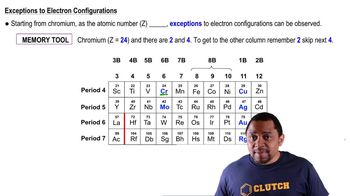The Electron Configurations: Exceptions definitions Flashcards
 Back
BackThe Electron Configurations: Exceptions definitions
1/15
Terms in this set (15)
- Electron ConfigurationArrangement of electrons in an atom's orbitals, following specific rules for stability.
- SubshellA division of electron shells, consisting of orbitals with the same energy level.
- OrbitalA region in an atom where there is a high probability of finding electrons.
- StabilityThe tendency of an atom to maintain a balanced electron configuration.
- SymmetryA balanced arrangement of electrons in orbitals, contributing to stability.
- ChromiumAn element with an electron configuration exception, promoting stability by half-filling d orbitals.
- CopperAn element that achieves stability by completely filling its d orbitals, deviating from expected configuration.
- Transition ElementsElements in the d-block of the periodic table, often showing electron configuration exceptions.
- Aufbau PrincipleA rule stating electrons fill orbitals starting from the lowest energy level.
- Hund's RuleA principle stating electrons fill degenerate orbitals singly before pairing.
- Degenerate OrbitalsOrbitals that have the same energy level within a subshell.
- Half-filled OrbitalsA stable electron configuration where each orbital in a subshell has one electron.
- Fully-filled OrbitalsA stable electron configuration where all orbitals in a subshell are completely filled.
- Atomic NumberThe number of protons in an atom's nucleus, determining its element.
- PromotionThe process of moving an electron to a higher energy orbital to achieve stability.



